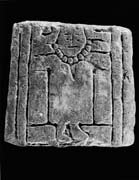Select a site alphabetically from the choices shown in the box below. Alternatively, browse sculptural examples using the Forward/Back buttons.
Chapters for this volume, along with copies of original in-text images, are available here.
Object type: Part of cross-shaft [1]
Measurements: H. 30.5 cm (12 in); W. 29.8 cm (11.75 in); D. 15.8 cm (6.25 in)
Stone type: Coarse-grained (with well-rounded grains up to 4 mm, and calcareous cement), very pale brown (10YR 8/3) sandstone; see no. 1
Plate numbers in printed volume: 522-525
Corpus volume reference: Vol 3 p. 156
(There may be more views or larger images available for this item. Click on the thumbnail image to view.)
A (broad): The edge moulding is double and flat. Within is a crudely cut, standing human, fitted tightly between broad vertical areas. The feet are turned to the right over a horizontal strip. Stumpy arms are extended laterally. The figure wears a long gown with V-neck. A row of pellets clings closely to the curving line of the chin. The facial features are rudimentary. Behind the head are obscure horizontal elements.
B and D (narrow): The edge moulding is flat. The panel contains what may be a form of ring-chain with pellet fillers down the centre, or perhaps of simple pattern F, executed in stopped-plait technique.
C (broad): The edge moulding is double and flat. The panel contains a compressed, S-shaped ribbon beast with broad contoured outlines. The head, at the lower end, has a snub jowl stemming immediately from the torso. The foot, crammed against the frame, above, is three-toed. Four simple transverse bars cross the ribbon body. Two pear-shaped spaces are all that remain, both within the curves of the body.
This is very rustic work, based on the more ambitious crosses at Middleton: a secular portrait, backed by a dragon, and interlaced narrow sides. The cutting is rudimentary so that all the embellishments of the Ryedale bound dragon have virtually disappeared. In the portrait there are no difficult details attempted. The ring-chain does work logically and should be compared with Pickering 2 (Ill. 755).
The figure on face A has a strange neck-line. It is possible that the pellets represent a collar or noose, in which case the figure may be the hanged Oðinn (Bailey 1980, 134, fig. 25), but the carving is too crude for such judgements to be made safely.



